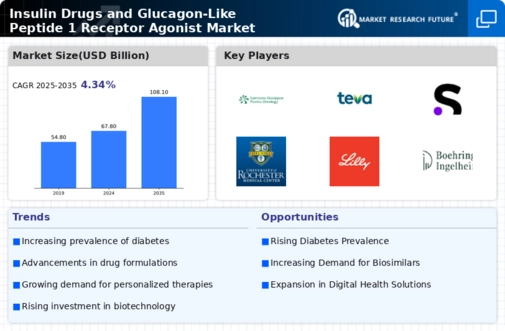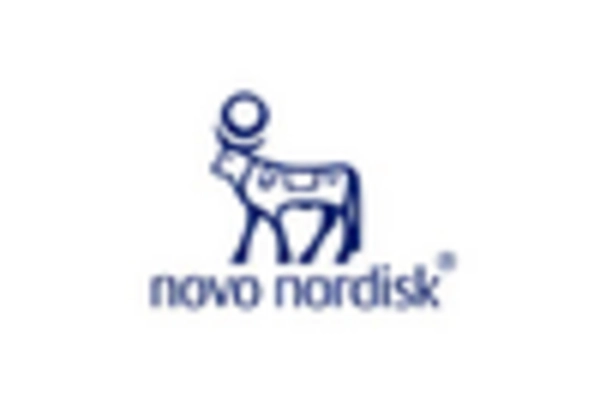Rising Geriatric Population
The aging population is a critical factor influencing the Insulin Drugs and Glucagon-Like Peptide 1 Receptor Agonist Market. As individuals age, the risk of developing type 2 diabetes increases, leading to a higher demand for insulin and GLP-1 receptor agonist therapies. Current demographic trends indicate that by 2050, the number of people aged 60 and above will double, creating a substantial market for diabetes management solutions. This demographic shift necessitates the development of tailored therapies that cater to the unique needs of older patients, including considerations for polypharmacy and comorbidities. As a result, pharmaceutical companies are likely to focus on creating formulations that are both effective and safe for the elderly, thereby driving growth in the insulin and GLP-1 receptor agonist market.
Advancements in Drug Formulations
Innovations in drug formulations are significantly influencing the Insulin Drugs and Glucagon-Like Peptide 1 Receptor Agonist Market. Recent developments have led to the creation of long-acting insulin analogs and novel GLP-1 receptor agonists that offer improved efficacy and patient compliance. For instance, the introduction of once-weekly formulations has transformed treatment regimens, making it easier for patients to manage their diabetes. Market data suggests that these advancements are contributing to a projected compound annual growth rate of over 8% in the insulin and GLP-1 market segment. As pharmaceutical companies continue to invest in research and development, the availability of more effective and user-friendly options is likely to attract a broader patient base, thereby driving market expansion.
Increasing Prevalence of Diabetes
The rising incidence of diabetes worldwide is a primary driver for the Insulin Drugs and Glucagon-Like Peptide 1 Receptor Agonist Market. According to recent statistics, the number of adults diagnosed with diabetes has surged, with projections indicating that by 2045, approximately 700 million individuals will be affected. This alarming trend necessitates the development and distribution of effective insulin therapies and GLP-1 receptor agonists, which are essential for managing blood glucose levels. As healthcare systems strive to address this growing epidemic, the demand for innovative insulin drugs and GLP-1 receptor agonists is expected to escalate, thereby propelling market growth. Furthermore, the increasing awareness of diabetes management among patients and healthcare providers is likely to enhance the adoption of these therapies, further solidifying their role in the market.
Growing Focus on Preventive Healthcare
The increasing emphasis on preventive healthcare is reshaping the Insulin Drugs and Glucagon-Like Peptide 1 Receptor Agonist Market. Healthcare providers are increasingly advocating for early intervention strategies to manage diabetes and its complications. This shift towards preventive measures is fostering a greater demand for insulin therapies and GLP-1 receptor agonists, as they play a crucial role in maintaining optimal blood glucose levels and preventing long-term health issues. Market analysis indicates that the preventive healthcare sector is expected to grow significantly, with a notable increase in screening programs and patient education initiatives. Consequently, this trend is likely to enhance the uptake of insulin drugs and GLP-1 receptor agonists, further driving market growth as patients seek effective solutions to manage their health proactively.
Increased Investment in Diabetes Research
The surge in investment for diabetes research is propelling the Insulin Drugs and Glucagon-Like Peptide 1 Receptor Agonist Market. Governments and private entities are allocating substantial funds to explore innovative treatment options and improve existing therapies. This influx of capital is fostering collaborations between academic institutions and pharmaceutical companies, leading to breakthroughs in drug development. Recent reports indicate that funding for diabetes research has increased by over 20% in the past few years, highlighting the commitment to addressing this pressing health issue. As new therapies emerge from this research, the market for insulin drugs and GLP-1 receptor agonists is expected to expand, providing patients with more effective and diverse treatment options.


















Leave a Comment